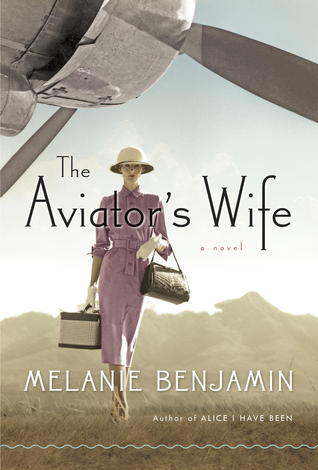Interview: Melanie Benjamin
 Melanie Benjamin is a pseudonym for Melanie Hauser, author of the nationally bestselling Alice I Have Been, The Autobiography of Mrs. Tom Thumb, and most recently The Aviator’s Wife, a novel about Anne Morrow Lindbergh. Born in Indianapolis, Indiana, she currently lives in Chicago.
Melanie Benjamin is a pseudonym for Melanie Hauser, author of the nationally bestselling Alice I Have Been, The Autobiography of Mrs. Tom Thumb, and most recently The Aviator’s Wife, a novel about Anne Morrow Lindbergh. Born in Indianapolis, Indiana, she currently lives in Chicago.
Midwestern Gothic: First things first, tell us about your Midwestern roots.
Melanie Benjamin: I was born and raised in Indianapolis, Indiana, to parents who grew up there as well, although my mother was born in Effingham, IL. My husband grew up in Indianapolis too, although we moved away in 1990, to the east (Philadelphia area). But we eventually found our way back to the Midwest, to Chicago.
MG: The Aviator’s Wife is a novel about Anne Morrow Lindbergh, the third historical novel you’ve written after The Autobiography of Mrs. Tom Thumb and Alice I Have Been. How did you decide to write about Anne Morrow Lindbergh for your third historical novel?
MB: After writing two novels set in the Victorian age, I wanted to move into the twentieth century. And in the early part of the twentieth century there was no more romantic, dashing idea than the early years of aviation, so I soon found myself looking for stories of that era. I discovered some interesting early female aviatrix and wing walkers, but none of their stories seemed “big” enough. Then I realized that there is no bigger name from those years than Lindbergh. That name looms over our collective memory and imagination still, but I think for vague reasons; few readers today know much of the Lindberghs’ story beyond his Paris flight and the tragic kidnapping of the baby. So I was drawn to the idea of telling Anne’s story, as it does seem to fit into my pattern of fictionalizing women whose stories have been told or overshadowed by the men in their lives. And too, I saw Anne’s journey from a shy schoolgirl to a daring aviatrix who nonetheless allowed her husband to speak for her and shape her life, to the woman who could write the proto-feminist “Gift From the Sea” in 1955, as a parallel to women’s journey during the first part of the twentieth century. We don’t quite get to Gloria Steinem and Betty Friedan through Anne, but her struggle for identity and a life of her own outside her iconic marriage is one that all women should know.
MG: With historical fiction, I’m sure you pick different stories to tell for different reasons. Is there any particular element of the story you are researching, maybe the setting, the characters, the time period, that is a more deciding factor than others?
MB: It’s always the character for me. I have to be able to get inside this protagonist’s skin. And there have been fascinating people with fascinating stories to tell with whom I simply haven’t been able to do that. I have discarded novels that I think, in terms of pure story and scope, were definitely novel-worthy. But I couldn’t get inside the protagonist, understand her, make her come to life. So that’s the key for me; I have to be able to assume this person, see the world through her eyes, like an actress choosing a role.
MG: As a true Midwesterner, what do you think defines this place?
MB: Honestly, the land; the flatness, the corn fields, the soybean fields, the streets all laid out in grids, easy to follow. When we lived in the northeast, I was always confused! Streets did not always run north-to-south or east-to-west; they would meander and change direction and names without any reason, it seemed to me, and I missed how easy it was to get around in the Midwest. Even living in a city like Indianapolis, you grew up with a sense of the land; farm terms were just absorbed from birth. Every radio station had a farm report at noon. “Knee-high by Fourth of July,” for example; of course, that’s how high the corn should be by then. Doesn’t everyone know this? But I’ve discovered that they don’t. And when I was in high school, the go-to summer job was corn detassling! So the land, and what it means, and how close we always are to it, defines the Midwest for me.
 MG: One of the big things we focus on at Midwestern Gothic is how overlooked the region is, both from a cultural/literary perspective. Can you elaborate on why you agree or disagree?
MG: One of the big things we focus on at Midwestern Gothic is how overlooked the region is, both from a cultural/literary perspective. Can you elaborate on why you agree or disagree?
MB: Well, I do think there’s definitely a “Southern fiction” tradition, and then obviously a “New York” type of book. But is there a Midwestern? I’m not sure, at least not since Sherwood Anderson and Sinclair Lewis and Theodore Dreiser. They did seem to write with a strong sense of this place. But for some authors—and I admit I’m one of them—the Midwest seems to inspire a longing for other places. I grew up in Indianapolis but dreamed of living elsewhere, some big, bustling, exotic city. Perhaps the quiet and the relative peacefulness of the Midwest allows some of us to dream big, bigger than we might have if we’d grown up elsewhere. So we may not write of the place, but the place allowed us space to dream and imagine and create.
MG: What is the most influential book you’ve read?
MB: Talking about the Southern literary tradition, Gone with the Wind. It was the first grown up book I read (and I was only in grade school or junior high when I read it!). But it opened up this amazing world, so new to me, full of different stories and traditions and history, not to mention just being a whopping great story. It really showed me how good fiction can entertain, but also inspire further learning.
MG: What’s the weirdest thing you’ve seen in the Midwest?
MB: Concrete animals. For some reason, certain smaller towns in the Midwest have a fondness for large concrete animals parked in front of stores and businesses. Muncie, Indiana, is a good example of that!
MG: What’s next for you?
MB: I wish I could tell you! I am writing another work of biographical fiction, another woman whose story you may think you know, but you really don’t. But I can’t say who it is just yet.






